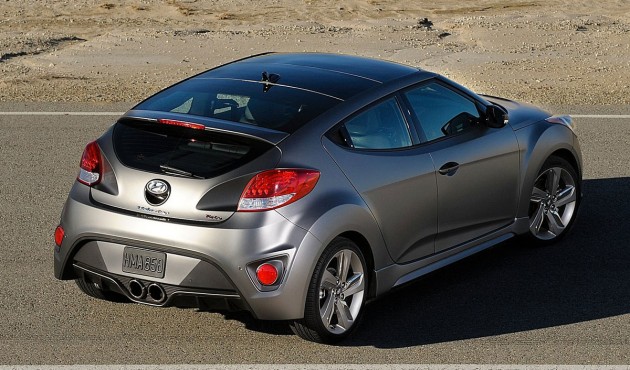The Hyundai Veloster reached Thailand recently, imported from Korea in two forms – naturally aspirated and Turbo. The former is powered by a 1.6 litre Gamma MPI engine, just like the Veloster that was launched in Malaysia last November. The Turbo is a more interesting proposition.
Powered by a Gamma 1.6 T-GDI engine, the Thai-market Veloster Turbo makes 186 PS and 265 Nm of torque from 1,500 to 4,500 rpm. Less power than the US-market car with 201 hp, but identical to the one sold in UK. Not quite Golf GTI-fast, but more go to match the racy looks for sure.
Unique to Hyundai’s twin-scroll turbocharger setup is a patent-pending one-piece cast design for the stainless steel exhaust manifold and the twin-scroll turbine housing, as well as a motor-driven electrical controller for the waste-gate. No manual for Thailand, so it’s a six-speed torque converter auto doing transmission duties.
If the Turbo looks slightly different, it is. There’s a bigger, bolder hexagonal front grille, sculpted side skirts and a new rear bumper with prominent diffuser vents. Those conspicuous twin round central pipes are also unique, as are the 18-inch wheels. The front vented disc brakes are also bigger – 300 vs 280 mm. In Thailand, this Korean is priced at 1.739 million baht (RM182k).
So will the Veloster Turbo make its way to Malaysia? It can’t be ruled out, but some special testing and/or mods might be required – the Thai Veloster Turbo’s T-GDI engine is Euro 5 rated. Might not be that viable for what will be a low-volume seller, but who knows?
Click here for our Veloster local launch report and here to see more of the Veloster Turbo.
Looking to sell your car? Sell it with Carro.













AI-generated Summary ✨
Comments highlight the high import and excise taxes making the Hyundai Veloster Turbo expensive in Malaysia, with prices possibly reaching RM180k-RM200k, which many consider overpriced compared to competitors like the Ford Focus ST and Golf GTI. There are concerns about the car’s design and performance, with some finding it unattractive and underpowered for the price. Several comments mention the absence of a manual transmission and the lack of availability of Euro 4/5 fuel standards in Malaysia, which could affect the engine's performance and longevity. Others express disappointment that the car hasn't been spotted on Malaysian roads, implying poor market reception and confusion over pricing strategy. Overall, sentiments lean towards skepticism about the car's value in Malaysia due to high costs, design issues, and market relevance.